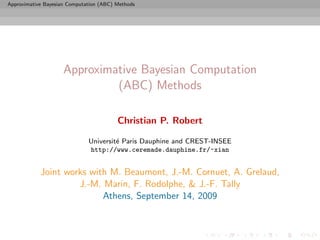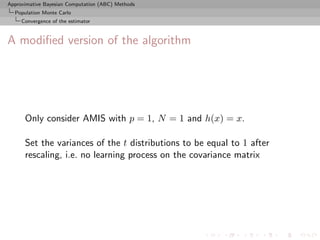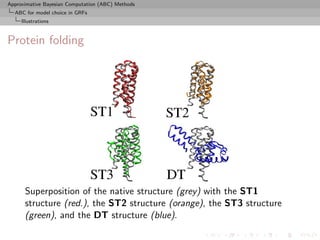The document describes Approximate Bayesian Computation (ABC) methods. It introduces Population Monte Carlo (PMC), which is an ABC algorithm that uses sequential importance sampling to generate particles from successive approximations of the target distribution. PMC proceeds by sampling particles from a proposal distribution, weighting them by the ratio of the target to proposal densities, and resampling according to the weights. The weighted samples across iterations are then used to estimate expectations with respect to the target distribution.



![Approximative Bayesian Computation (ABC) Methods
Introduction
Monte Carlo basics
Monte Carlo basics
Generate an iid sample x1 , . . . , xN from π and estimate Π(h) by
N
ˆN
ΠM C (h) = N −1 h(xi ).
i=1
ˆN as
LLN: ΠM C (h) −→ Π(h)
If Π(h2 ) = h2 (x)π(x)µ(dx) < ∞,
√ L
CLT: ˆN
N ΠM C (h) − Π(h) N 0, Π [h − Π(h)]2 .](https://image.slidesharecdn.com/athens-090915150039-phpapp01/85/Athens-workshop-on-MCMC-4-320.jpg)
![Approximative Bayesian Computation (ABC) Methods
Introduction
Monte Carlo basics
Monte Carlo basics
Generate an iid sample x1 , . . . , xN from π and estimate Π(h) by
N
ˆN
ΠM C (h) = N −1 h(xi ).
i=1
ˆN as
LLN: ΠM C (h) −→ Π(h)
If Π(h2 ) = h2 (x)π(x)µ(dx) < ∞,
√ L
CLT: ˆN
N ΠM C (h) − Π(h) N 0, Π [h − Π(h)]2 .
Caveat
Often impossible or inefficient to simulate directly from Π](https://image.slidesharecdn.com/athens-090915150039-phpapp01/85/Athens-workshop-on-MCMC-5-320.jpg)









![Approximative Bayesian Computation (ABC) Methods
Population Monte Carlo
PMC: Population Monte Carlo Algorithm
At time t = 0
iid
Generate (xi,0 )1≤i≤N ∼ Q0
Set ωi,0 = {π/q0 }(xi,0 )
iid
Generate (Ji,0 )1≤i≤N ∼ M(1, (¯ i,0 )1≤i≤N )
ω
Set xi,0 = xJi ,0
˜
At time t (t = 1, . . . , T ),
ind
Generate xi,t ∼ Qi,t (˜i,t−1 , ·)
x
Set ωi,t = {π(xi,t )/qi,t (˜i,t−1 , xi,t )}
x
iid
Generate (Ji,t )1≤i≤N ∼ M(1, (¯ i,t )1≤i≤N )
ω
Set xi,t = xJi,t ,t .
˜
[Capp´, Douc, Guillin, Marin, & CPR, 2009, Stat.& Comput.]
e](https://image.slidesharecdn.com/athens-090915150039-phpapp01/85/Athens-workshop-on-MCMC-15-320.jpg)



![Approximative Bayesian Computation (ABC) Methods
Population Monte Carlo
Improving quality
The efficiency of the SNIS approximation depends on the choice of
Q, ranging from optimal
q(x) ∝ |h(x) − Π(h)|π(x)
to useless
ˆ Q,N
var ΠSN IS (h) = +∞
Example (PMC=adaptive importance sampling)
Population Monte Carlo is producing a sequence of proposals Qt
aiming at improving efficiency
Kull(π, qt ) ≤ Kull(π, qt−1 ) or ˆ Q ,∞ ˆ Q ,∞
var ΠSN IS (h) ≤ var ΠSN IS (h)
t t−1
[Capp´, Douc, Guillin, Marin, Robert, 04, 07a, 07b, 08]
e](https://image.slidesharecdn.com/athens-090915150039-phpapp01/85/Athens-workshop-on-MCMC-19-320.jpg)


![Approximative Bayesian Computation (ABC) Methods
Population Monte Carlo
AMIS
Mixture representation
Deterministic mixture correction of the weights proposed by Owen
and Zhou (JASA, 2000)
The corresponding estimator is still unbiased [if not
self-normalised]
All particles are on the same weighting scale rather than their
own
Large variance proposals Qt do not take over
Variance reduction thanks to weight stabilization & recycling
[K.o.] removes the randomness in the component choice
[=Rao-Blackwellisation]](https://image.slidesharecdn.com/athens-090915150039-phpapp01/85/Athens-workshop-on-MCMC-22-320.jpg)





![Approximative Bayesian Computation (ABC) Methods
Population Monte Carlo
Convergence of the estimator
Convergence of the AMIS estimator
Difficulty in establishing the convergence because of the backward
structure: the weight of xt at stage T depends on future as well as
i
past xℓ ’...
j
Regular Population Monte Carlo argument does not work for T
asymptotics...
[ c Amiss estimator?!]](https://image.slidesharecdn.com/athens-090915150039-phpapp01/85/Athens-workshop-on-MCMC-28-320.jpg)










![Approximative Bayesian Computation (ABC) Methods
ABC
The ABC method
Bayesian setting: target is π(θ)f (x|θ)
When likelihood f (x|θ) not in closed form, likelihood-free rejection
technique:
ABC algorithm
For an observation y ∼ f (y|θ), under the prior π(θ), keep jointly
simulating
θ′ ∼ π(θ) , x ∼ f (x|θ′ ) ,
until the auxiliary variable x is equal to the observed value, x = y.
[Pritchard et al., 1999]](https://image.slidesharecdn.com/athens-090915150039-phpapp01/85/Athens-workshop-on-MCMC-39-320.jpg)



![Approximative Bayesian Computation (ABC) Methods
ABC
ABC improvements
Simulating from the prior is often poor in efficiency
Either modify the proposal distribution on θ to increase the density
of x’s within the vicinity of y...
[Marjoram et al, 2003; Bortot et al., 2007, Sisson et al., 2007]](https://image.slidesharecdn.com/athens-090915150039-phpapp01/85/Athens-workshop-on-MCMC-43-320.jpg)
![Approximative Bayesian Computation (ABC) Methods
ABC
ABC improvements
Simulating from the prior is often poor in efficiency
Either modify the proposal distribution on θ to increase the density
of x’s within the vicinity of y...
[Marjoram et al, 2003; Bortot et al., 2007, Sisson et al., 2007]
...or by viewing the problem as a conditional density estimation
and by developing techniques to allow for larger ǫ
[Beaumont et al., 2002]](https://image.slidesharecdn.com/athens-090915150039-phpapp01/85/Athens-workshop-on-MCMC-44-320.jpg)
![Approximative Bayesian Computation (ABC) Methods
ABC
ABC improvements
Simulating from the prior is often poor in efficiency
Either modify the proposal distribution on θ to increase the density
of x’s within the vicinity of y...
[Marjoram et al, 2003; Bortot et al., 2007, Sisson et al., 2007]
...or by viewing the problem as a conditional density estimation
and by developing techniques to allow for larger ǫ
[Beaumont et al., 2002]
...or even by including ǫ in the inferential framework [ABCµ ]
[Ratmann et al., 2009]](https://image.slidesharecdn.com/athens-090915150039-phpapp01/85/Athens-workshop-on-MCMC-45-320.jpg)

![Approximative Bayesian Computation (ABC) Methods
ABC
ABC-MCMC
Markov chain (θ(t) ) created via the transition function
θ′ ∼ K(θ′ |θ(t) ) if x ∼ f (x|θ′ ) is such that x = y
(t+1) π(θ′ )K(θ(t) |θ′ )
θ = and u ∼ U(0, 1) ≤ π(θ(t) )K(θ′ |θ(t) ) ,
(t)
θ otherwise,
has the posterior π(θ|y) as stationary distribution
[Marjoram et al, 2003]](https://image.slidesharecdn.com/athens-090915150039-phpapp01/85/Athens-workshop-on-MCMC-47-320.jpg)
![Approximative Bayesian Computation (ABC) Methods
ABC
ABCµ
[Ratmann, Andrieu, Wiuf and Richardson, 2009, PNAS]
Use of a joint density
f (θ, ǫ|x0 ) ∝ ξ(ǫ|x0 , θ) × πθ (θ) × πǫ (ǫ)
where x0 is the data, and ξ(ǫ|x0 , θ) is the prior predictive density
of ρ(S(x), S(x0 )) given θ and x0 when x ∼ f (x|θ)
Replacement of ξ(ǫ|x0 , θ) with a non-parametric kernel
approximation.](https://image.slidesharecdn.com/athens-090915150039-phpapp01/85/Athens-workshop-on-MCMC-48-320.jpg)

![Approximative Bayesian Computation (ABC) Methods
ABC
Questions about ABCµ
For each model under comparison, marginal posterior on ǫ used to
assess the fit of the model (HPD includes 0 or not).
Is the data informative about ǫ? [Identifiability]
How is the prior π(ǫ) impacting the comparison?
How is using both ξ(ǫ|x0 , θ) and πǫ (ǫ) compatible with a
standard probability model?
Where is there a penalisation for complexity in the model
comparison?](https://image.slidesharecdn.com/athens-090915150039-phpapp01/85/Athens-workshop-on-MCMC-50-320.jpg)

![Approximative Bayesian Computation (ABC) Methods
ABC
ABC-PRC
Another sequential version producing a sequence of Markov
(t) (t)
transition kernels Kt and of samples (θ1 , . . . , θN ) (1 ≤ t ≤ T )
ABC-PRC Algorithm
(t−1)
1 Pick a θ⋆ is selected at random among the previous θi ’s
(t−1)
with probabilities ωi (1 ≤ i ≤ N ).
2 Generate
(t) (t)
θi ∼ Kt (θ|θ⋆ ) , x ∼ f (x|θi ) ,
3 Check that ̺(x, y) < ǫ, otherwise start again.
[Sisson et al., 2007]](https://image.slidesharecdn.com/athens-090915150039-phpapp01/85/Athens-workshop-on-MCMC-52-320.jpg)




![Approximative Bayesian Computation (ABC) Methods
ABC
ABC-PRC bias
Lack of unbiasedness of the method
Joint density of the accepted pair (θ(t−1) , θ(t) ) proportional to
(t−1) (t) (t−1) (t)
π(θ |y)Kt (θ |θ )f (y|θ ),
For an arbitrary function h(θ), E[ωt h(θ(t) )] proportional to
π(θ (t) )Lt−1 (θ (t−1) |θ (t) )
ZZ
(t) (t−1) (t) (t−1) (t) (t−1) (t)
h(θ ) π(θ |y)Kt (θ |θ )f (y|θ )dθ dθ
π(θ (t−1) )Kt (θ (t) |θ (t−1) )
π(θ (t) )Lt−1 (θ (t−1) |θ (t) )
ZZ
(t) (t−1) (t−1)
∝ h(θ ) π(θ )f (y|θ )
π(θ (t−1) )Kt (θ (t) |θ (t−1) )
(t) (t−1) (t) (t−1) (t)
× Kt (θ |θ )f (y|θ )dθ dθ
Z Z ff
(t) (t) (t−1) (t) (t−1) (t−1) (t)
∝ h(θ )π(θ |y) Lt−1 (θ |θ )f (y|θ )dθ dθ .](https://image.slidesharecdn.com/athens-090915150039-phpapp01/85/Athens-workshop-on-MCMC-57-320.jpg)

![Approximative Bayesian Computation (ABC) Methods
ABC-PMC
A PMC version
Use of the same kernel idea as ABC-PRC but with IS correction
Generate a sample at iteration t by
N
(t−1) (t−1)
πt (θ(t) ) ∝
ˆ ωj Kt (θ(t) |θj )
j=1
modulo acceptance of the associated xt , and use an importance
(t)
weight associated with an accepted simulation θi
(t) (t) (t)
ωi ∝ π(θi ) πt (θi ) .
ˆ
c Still likelihood free
[Beaumont et al., 2008, arXiv:0805.2256]](https://image.slidesharecdn.com/athens-090915150039-phpapp01/85/Athens-workshop-on-MCMC-59-320.jpg)

![Approximative Bayesian Computation (ABC) Methods
ABC-PMC
ABC-SMC
[Del Moral, Doucet & Jasra, 2009]
True derivation of an SMC-ABC algorithm
Use of a kernel Kn associated with target πǫn and derivation of the
backward kernel
πǫn (z ′ )Kn (z ′ , z)
Ln−1 (z, z ′ ) =
πn (z)
Update of the weights
M m
m=1 Aǫ⋉ (xin
win ∝i(n−1) M m
m=1 Aǫ⋉− (xi(n−1)
when xm ∼ K(xi(n−1) , ·)
in](https://image.slidesharecdn.com/athens-090915150039-phpapp01/85/Athens-workshop-on-MCMC-61-320.jpg)
![Approximative Bayesian Computation (ABC) Methods
ABC-PMC
A mixture example (0)
Toy model of Sisson et al. (2007): if
θ ∼ U(−10, 10) , x|θ ∼ 0.5 N (θ, 1) + 0.5 N (θ, 1/100) ,
then the posterior distribution associated with y = 0 is the normal
mixture
θ|y = 0 ∼ 0.5 N (0, 1) + 0.5 N (0, 1/100)
restricted to [−10, 10].
Furthermore, true target available as
π(θ||x| < ǫ) ∝ Φ(ǫ−θ)−Φ(−ǫ−θ)+Φ(10(ǫ−θ))−Φ(−10(ǫ+θ)) .](https://image.slidesharecdn.com/athens-090915150039-phpapp01/85/Athens-workshop-on-MCMC-62-320.jpg)





![Approximative Bayesian Computation (ABC) Methods
ABC for model choice in GRFs
Gibbs random fields
Potts model
Potts model
Vc (y) is of the form
Vc (y) = θS(y) = θ δyl =yi
l∼i
where l∼i denotes a neighbourhood structure
In most realistic settings, summation
Zθ = exp{θT S(x)}
x∈X
involves too many terms to be manageable and numerical
approximations cannot always be trusted
[Cucala, Marin, CPR & Titterington, 2009]](https://image.slidesharecdn.com/athens-090915150039-phpapp01/85/Athens-workshop-on-MCMC-68-320.jpg)







![Approximative Bayesian Computation (ABC) Methods
ABC for model choice in GRFs
Model choice via ABC
Sufficient statistics
By definition, if S(x) sufficient statistic for the joint parameters
(M, θ0 , . . . , θM −1 ),
P(M = m|x) = P(M = m|S(x)) .
For each model m, own sufficient statistic Sm (·) and
S(·) = (S0 (·), . . . , SM −1 (·)) also sufficient.
For Gibbs random fields,
1 2
x|M = m ∼ fm (x|θm ) = fm (x|S(x))fm (S(x)|θm )
1
= f 2 (S(x)|θm )
n(S(x)) m
where
n(S(x)) = ♯ {˜ ∈ X : S(˜ ) = S(x)}
x x
c S(x) is therefore also sufficient for the joint parameters
[Specific to Gibbs random fields!]](https://image.slidesharecdn.com/athens-090915150039-phpapp01/85/Athens-workshop-on-MCMC-76-320.jpg)







